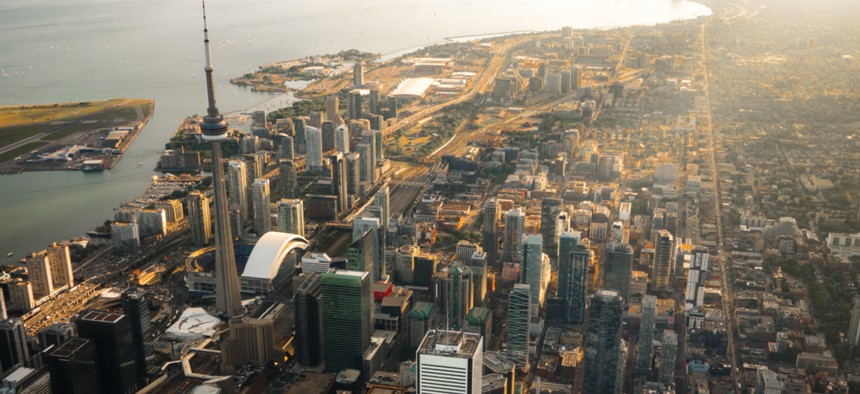Google Announces Plan to Turn Toronto Neighborhood into Living Laboratory

Dan Sedran/Shutterstock.com
The development is the company's first foray into what it has described as "rebuilding cities from the Internet up.”
Urban innovations company Sidewalk Labs and the Canadian government announced a partnership Tuesday to develop 750 acres along Toronto’s waterfront into what they envision as a high-tech living laboratory for solving urban problems. It would be the largest urban redevelopment project in North America.
“We have an opportunity to fundamentally redefine what urban life can actually be,” Sidewalk Labs CEO Dan Doctoroff said in an introductory video at a high profile press conference in Toronto. The company, founded in June 2015, is a subsidiary of Alphabet, Google’s parent company.
“Sidewalk Labs will create a test bed for new technologies in Quayside,” Canadian Prime Minister Justin Trudeau said. “Technologies to build smarter, greener, more inclusive cities, which we hope to see scaled across Toronto’s eastern waterfront, and eventually in other parts of Canada and around the world.”
The company, which has defined its mission as “reimagining cities from the Internet up,” considered several U.S. cities for a high-tech makeover before applying to develop the waterfront strip in Toronto. The project will be sited in Quayside, a barren waterfront plot near Toronto’s downtown. It will start relatively small; 12 acres yielding approximately three million square feet of development. However, on Tuesday, all parties involved expressed their intent for Sidewalk Labs to lead the redevelopment of the entire 750 acre eastern waterfront.
This is the same area that CityLab had previously identified as a potential Amazon HQ2 location. While it is not clear how this announcement might affect the city’s Amazon bid, it does represent a major commitment to raising the city’s profile as a tech hub. Trudeau said that Google will relocate its Canadian headquarters to Quayside “to anchor this innovation cluster.” For Google, too, this moment represents the culmination of “almost ten years” of city-building aspirations, Alphabet Chairman Eric Schmidt said at the event.
Finding innovative ways to create affordable housing, improve transportation, and live in harmony with the environment were among the other goals articulated by the project’s representatives. Over the coming year, Sidewalk Labs and city officials will consult with local residents and businesses about what they would like to see in the new development.
As former Deputy Mayor for Economic Development of New York City, Doctoroff does not lack for experience in these fields. During his tenure, he presided over the large-scale rezoning of Manhattan, as well as projects like the High Line, the World Trade Center reconstruction, and Hudson Yards. As a brand new neighborhood filled with high tech sensors in the middle of an old, dense city, Hudson Yards is probably the closest analog to Sidewalk Labs’ Toronto project.
Other observers have drawn comparisons between Sidewalk Labs and ongoing, ground-up smart cities like Songdo International Business District in South Korea and Masdar City in Abu Dhabi. Similar to master planned modernist cities like Brasilia, these smart cities have consistently failed to meet their utopian expectations. Songdo has been unable to attract significant business attention, while Masdar City has been beset by delays and won’t even come close to its goal of being carbon-neutral.
In his 2013 “pamphlet,” Against the Smart City, Adam Greenfield expresses concern that the companies developing smart cities, like IBM, Siemens, and now Google, will have too much control over the lives of city dwellers. “The wholesale surrender of municipal management to an algorithmic toolset would seem to repose an undue amount of trust in the party responsible for authoring the algorithm,” he writes.
While this does not appear to be Sidewalk Labs’ intent, the company’s plan to embed the latest technologies into the built environment may well fuel new ethical dilemmas. Significantly, Doctoroff and Schmidt avoided using the term “smart city” during the event. Instead, Doctoroff invoked Jane Jacobs, a crusader against urban environments that were overly controlled, who famously moved from New York City to Toronto.
NEXT STORY: This Tool Saves HUD Employees Weeks of Work


